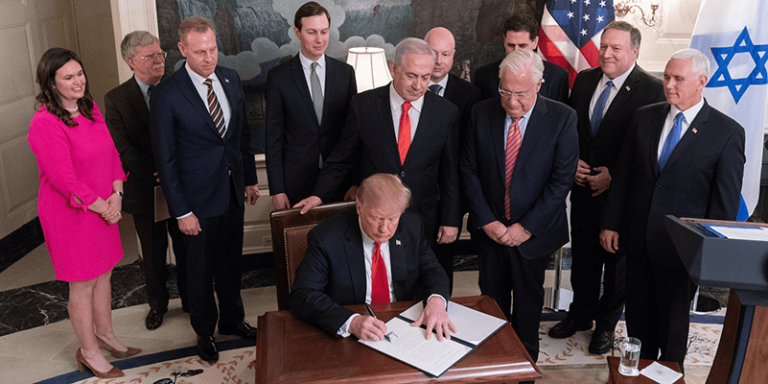
During a press conference with Israeli Prime Minister Benjamin Netanyahu on Monday, March 25, US President Donald Trump signed a presidential proclamation officially recognizing the Golan Heights as Israeli territory. This was preceded by a tweet from President Trump about the US intention to recognize Israeli sovereignty over the occupied Syrian Golan Heights, which sparked a storm of surprise in the Middle East. The proclamation was met by a response from the United Nations chief confirming that “the status of the Golan has not changed” and that UN policy is based on its historic resolutions on the matter. The League of Arab States and a number of Arab and Muslim leaders, as well as the European Union, had already condemned the move, following Trump’s tweet. In fact, one day after President Trump’s tweet, the UN Human Rights Council criticized Israeli expansion in the Golan and adopted a resolution brought by the Organization of the Islamic Conference.
Such a decision by the Trump Administration will have serious implications not only for US policy in Syria—one characterized by much confusion and lack of strategy—but also with regard to international law, of which the United States was a key architect after World War II.
International law, particularly UN Security Council Resolution 242, recognizes the Golan Heights as Syrian territory occupied by Israel. The resolution called for “secure and recognized boundaries free from threats or acts of force,” especially since it was Israel that occupied this Syrian territory after the 1967 war, along with the West Bank, East Jerusalem, Gaza, and the Sinai Peninsula. Nevertheless, Israel kept the Golan under its control. Moreover, the international community rejected Israel’s continued demands to annex the Golan and continued to pass an annual resolution at the UN General Assembly stipulating that the Golan is Syrian territory. The international community also called for an end to the Israeli occupation of the Golan, which it viewed as sovereign Syrian territory.
In 1967, Israel occupied two-thirds of the Golan Heights while the eastern third remained under the control of the Syrian government. Under the disengagement agreement reached in 1974, a UN force was maintained there to monitor the disengagement in the buffer zone of approximately 235 square kilometers. In 1981, Israel effectively annexed the Golan Heights when it approved the Golan Heights Law, which extended Israeli law and administration throughout the region. In Resolution 497, the United Nations Security Council condemned Israel’s annexation of the Golan Heights. The resolution states that “the Israeli decision to impose its laws, jurisdiction and administration in the occupied Syrian Golan Heights is null and void and without international legal effect.” The international community, including the United States, has maintained its position of rejecting Israeli demands to annex Syrian territory in the Golan, considering the Golan to be sovereign Syrian territory.
Since the beginning of the Syrian war in 2011, the Syrian-controlled part of the Golan Heights has been the scene of ongoing battles between the armed opposition factions, including the Nusra Front and fighters belonging to the Islamic State, and the forces of the Syrian regime. Control over the area has alternated between the two sides. During this period, there have been some attacks on the international UN forces stationed there. On two occasions in March and May of 2013, blue-helmet UN troops were seized by militants. Later in August 2014, 43 members of the UN Disengagement Observer Force in the buffer zone were detained by armed groups, while 81 were trapped. The headquarters of the UN forces was also damaged during this attack and almost completely evacuated. The detained UN personnel were subsequently released and the commitment to the presence of these forces was confirmed. Their presence was also renewed and their role in peacekeeping in that region was confirmed. The legal status of these forces did not change the status of the Golan Heights as Syrian territory occupied by Israel.
However, as the war in Syria escalated, Israeli voices, particularly those from the right wing, demanded that the opportunity be exploited to strengthen Israel’s declaration of full sovereignty over the Syrian Golan Heights and to change their legal and political status at the international level, and not only the domestic level. Within the US Congress today, voices calling for full recognition of Israeli sovereignty over the Golan Heights have grown despite the long-standing official US position that the Golan is Syrian territory.
In February 2019, a group of Republican senators led by Ted Cruz (R-Texas) introduced the bill S. 567 in an attempt to adopt an official US policy granting Israel’s full sovereignty over the Golan Heights. In the House of Representatives, these efforts are led by Representative Michael Gallagher (R-Wisconsin) with the bill H.R. 1372, also introduced in February of 2019. This movement gained momentum last year within the Republican Party because of Trump’s pro-Israel positions against the rights of the Palestinian people, primarily the transfer of the American embassy from Tel Aviv to Jerusalem, the cessation of funding for UNRWA, and the reduction of the PLO’s representation in Washington and closure of its offices altogether.
It is too early to predict if the Republican-controlled Senate or the Democratic-controlled House of Representatives will approve the proposed draft legislation. If Congress does approve such a move, it will clearly be the legislation of occupation.
President Trump initially announced this position through the tweet that he published this past week. He referred to the US recognition of Israeli sovereignty over the Golan while US Secretary of State Mike Pompeo was visiting Israel before the elections that are scheduled in April. Secretary Pompeo met Israeli Prime Minister Benjamin Netanyahu, who described this move as “historic.” It is noteworthy that recently, the US State Department dropped the term “Israeli-occupied” in its description of the Golan Heights when it issued its report on human rights in the world. This was considered an indication of changing the political status of the occupied Golan within the US State Department’s policy. On March 25, 2019, during a meeting with Israeli Prime Minister Netanyahu, President Trump made this official by signing a presidential proclamation recognizing the Golan Heights as Israeli territory.
The move exacerbates the confusion in US policy in the Middle East, placing Trump not only in unequivocal support of Israel but also in blind support for the polices of the far-right in Israel. This decision will have serious implications for international law and for the future policy of the United States in the Arab world.

